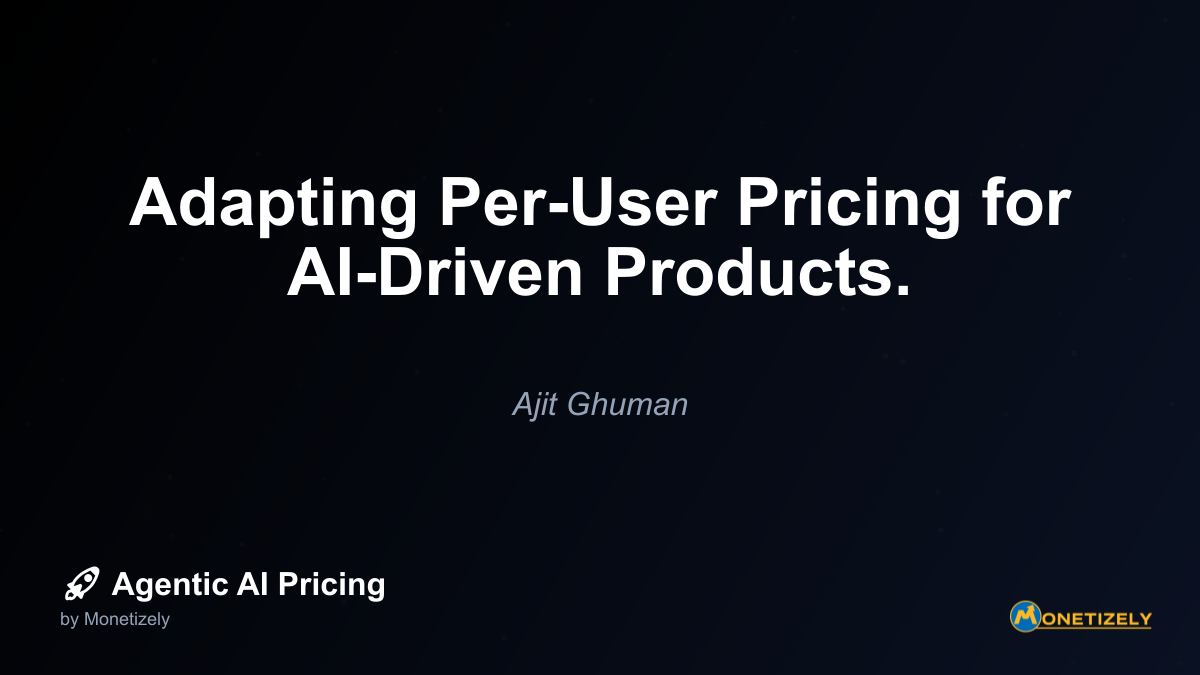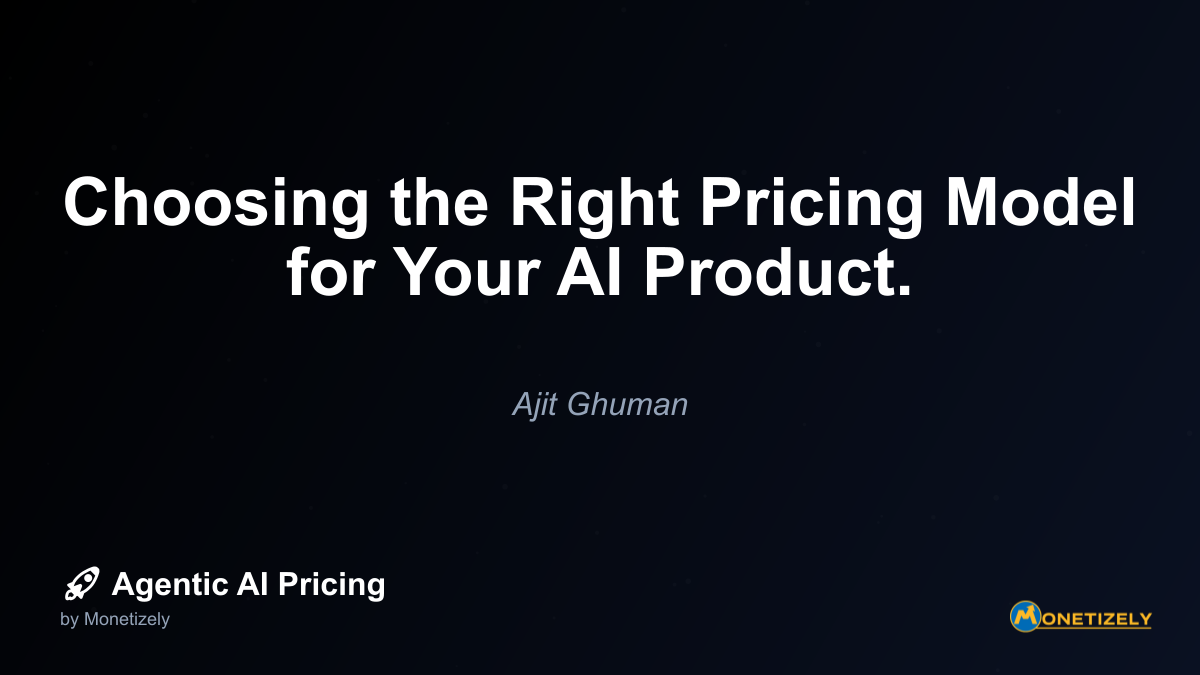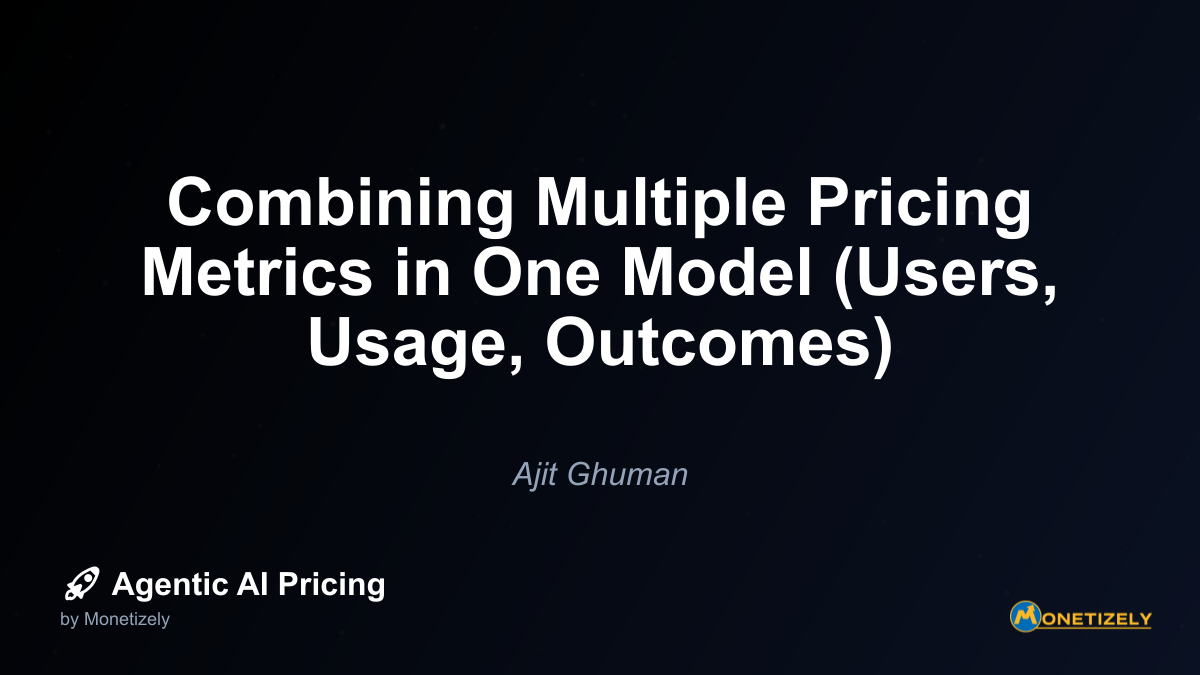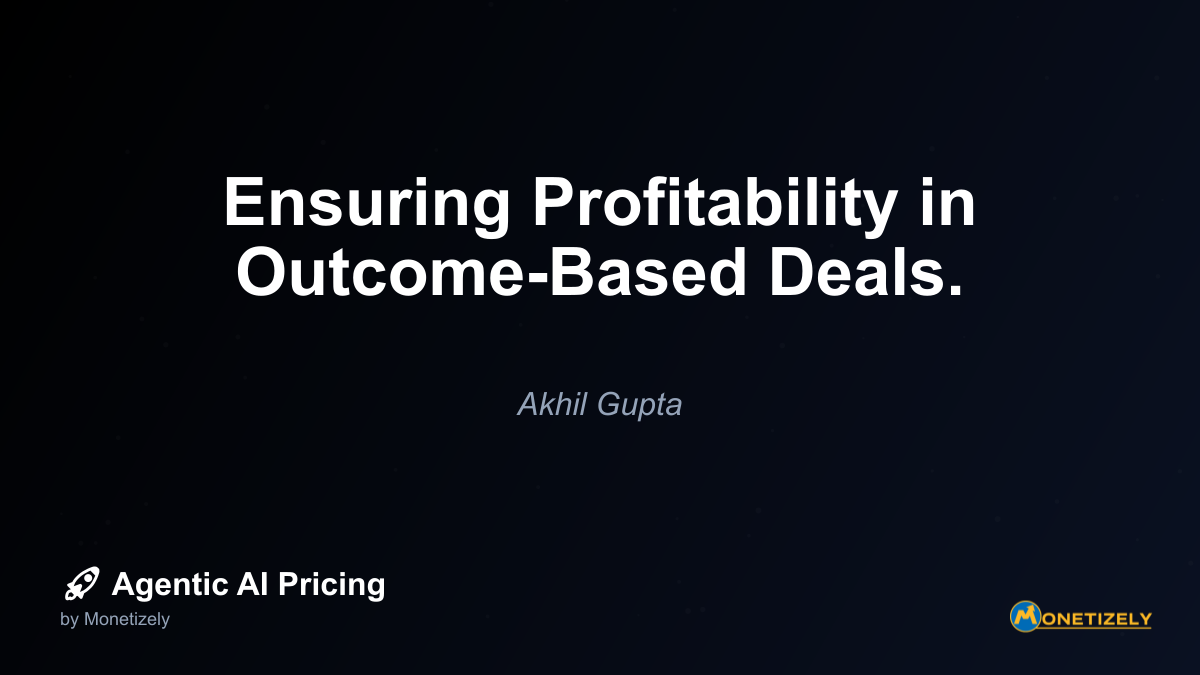· Akhil Gupta · Agentic AI Pricing Strategies · 12 min read
Per Agent Pricing Model: Licensing AI Agents like Employees.
AI and SaaS Pricing Masterclass
Learn the art of strategic pricing directly from industry experts. Our comprehensive course provides frameworks and methodologies for optimizing your pricing strategy in the evolving AI landscape. Earn a professional certification that can be imported directly to your LinkedIn profile.
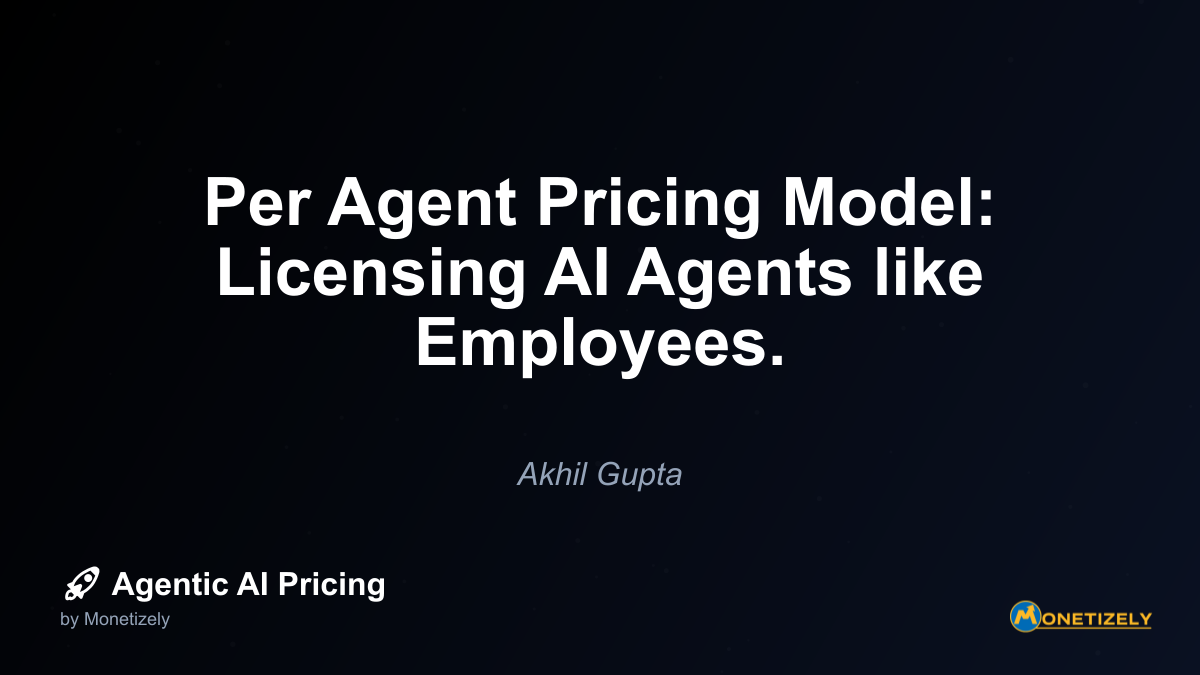
In today’s rapidly evolving AI landscape, organizations are increasingly adopting agent-based AI solutions to automate complex tasks and enhance productivity. As these technologies mature, a new pricing paradigm has emerged: the per-agent pricing model, which treats AI agents as virtual employees or software “seats” rather than traditional software licenses. This approach fundamentally shifts how businesses value, budget for, and measure the return on their AI investments.
Understanding Per-Agent Pricing: The Virtual Employee Model
Per-agent pricing conceptualizes each AI agent as an autonomous digital worker with its own “seat” in your organization. Unlike traditional software licensing that charges based on human users, this model prices according to the number of AI agents deployed, their capabilities, and often their workload or outcomes.
This pricing structure mirrors how organizations have historically budgeted for human employees—with base compensation plus performance-based incentives—but applied to digital agents that can work continuously without breaks, vacations, or benefits.
Core Characteristics of Per-Agent Pricing
- Fixed base fee per agent: A predictable monthly or annual cost per deployed agent
- Capability-based tiering: Higher prices for more sophisticated agent capabilities
- Workload or outcome components: Additional charges based on tasks completed or results achieved
- Volume discounts: Reduced per-agent costs when deploying multiple agents
- Performance guarantees: Service level agreements tied to agent performance
This approach represents a significant departure from traditional software pricing models, which typically charge based on human users, features, or broad usage rights. Instead, it acknowledges the autonomous, persistent nature of AI agents that operate continuously, making decisions and performing tasks without constant human oversight.
The Evolution from Software Seats to Digital Employees
Traditional software seat licensing developed when applications were tools used directly by humans. Users would log in, perform tasks, and log out. The value derived was directly tied to human interaction with the software.
AI agents fundamentally change this paradigm. They persist and operate autonomously, more like employees than tools. This shift necessitates new pricing approaches that better reflect how organizations derive value from autonomous AI.
Key Differences Between Traditional Seats and AI Agent Pricing
| Traditional Software Seats | AI Agent “Employees” |
|---|---|
| Licensed per human user | Licensed per autonomous agent |
| Value tied to human productivity | Value tied to agent outcomes |
| Predictable fixed costs | Hybrid fixed/variable costs |
| Measured by access/features | Measured by tasks/outcomes |
| Uniform pricing per seat | Tiered by agent capability |
As Harvey AI’s co-founder Winston Weinberg noted in a recent interview: “When your AI is making decisions and executing tasks continuously like an employee would, the pricing model needs to reflect that autonomous value creation rather than just access rights.”
Market Adoption and Pricing Examples
The per-agent pricing model has gained significant traction in the market, with various implementations across industries and use cases. Here are some notable examples from 2023-2025:
Legal Industry: Harvey AI
Harvey AI offers AI agents to large law firms using a high per-seat monthly subscription pricing model. Reports indicate pricing of approximately $1,200+ per agent per month for large firms, with scaled tiers for smaller firms starting at about $500 per year during pilot phases.
This premium pricing reflects the high value of legal work, where lawyers bill at rates up to $800/hour. The ROI calculation becomes straightforward: if an AI agent saves even a few hours of lawyer time per month, it quickly justifies its cost.
Sales Automation: SuperAGI
SuperAGI implemented AI sales agents that handle initial outreach and lead qualification. Their pricing model includes a base fee per agent with performance-based components tied to outcomes like demo requests and proposals submitted.
A case study from their enterprise tech client revealed impressive results:
- 35% increase in demo requests
- 27% more proposals submitted
- 12% reduction in sales and marketing expenses (saving $230,000 per quarter)
- Reduced sales cycle length from 120 to 90 days
These metrics align with broader industry studies showing 25% sales productivity boosts and 15% reduction in sales cycle length with AI adoption.
Enterprise AI: Microsoft and Salesforce
Major enterprise vendors have adopted varied approaches to AI agent pricing:
- Microsoft charges approximately $4 per AI agent hour for their autonomous business process agents
- Salesforce uses a usage-based model at around $2 per conversation for their customer service AI agents
- OpenAI prices specialized autonomous AI agents between $2,000 to $20,000 per month, depending on capability level (e.g., knowledge worker agents, developer agents, PhD-level research agents)
This range illustrates how pricing scales with agent sophistication and the value of the tasks being automated. OpenAI’s premium pricing positions their advanced agents favorably compared to human professional hourly rates while offering 24/7 availability.
Scenarios Where Per-Agent Pricing Works Well
The per-agent pricing model isn’t universally optimal but shows particular strength in specific business contexts:
1. High-Value Knowledge Work Automation
When AI agents replace or augment expensive knowledge workers (lawyers, consultants, developers, researchers), the ROI calculation is straightforward. If a human professional costs $150-$800 per hour, an AI agent priced at $1,000-$20,000 per month can deliver substantial savings while working continuously.
Legal document review, financial analysis, and specialized research are prime examples where the per-agent model aligns well with the high value delivered.
2. Predictable Workload Scenarios
Organizations with stable, predictable AI agent needs benefit from the budgeting clarity of per-agent pricing. Enterprise customer service operations, ongoing sales outreach, and routine compliance monitoring all feature relatively consistent agent utilization, making fixed per-agent costs easier to justify and forecast.
3. Outcome-Focused Applications
When AI agent value is directly tied to measurable business outcomes—closed sales, resolved support tickets, processed claims—per-agent pricing with performance components creates perfect alignment between vendor and customer incentives.
4. Markets Accustomed to Staffing Models
Industries already familiar with staffing-based pricing (consulting, BPO, professional services) adapt more readily to per-agent models. They’re comfortable evaluating the economics of adding “digital staff” alongside human resources.
As Deloitte’s AI Strategy Lead noted in a 2024 report: “Organizations that view AI agents as augmenting their workforce rather than simply as software tools tend to achieve 3.2x greater ROI on their AI investments.”
Risks of Per-Agent Pricing When Agents Underperform
Despite its advantages, the per-agent pricing model carries significant risks when AI agents fail to deliver expected value:
1. Fixed Costs Without Proportional Value
Unlike usage-based models where costs scale with actual utilization, per-agent pricing means paying full price regardless of how frequently the agent is used or how effectively it performs. If an agent handles fewer tasks than anticipated or performs them poorly, the fixed cost remains unchanged.
2. Difficult Performance Evaluation
Determining whether an AI agent is underperforming can be challenging, especially for complex knowledge tasks without clear metrics. This creates potential disconnect between ongoing costs and perceived value.
3. Sunk Cost Fallacy
Organizations may continue paying for underperforming agents due to the investment already made in implementation and integration, even when the ROI no longer justifies the expense.
4. Budget Inflexibility
Fixed per-agent costs can strain budgets during business downturns when usage decreases but costs remain constant, unlike human resources which can be more flexibly adjusted.
5. Technology Obsolescence Risk
As AI technology rapidly evolves, organizations locked into per-agent contracts for specific agent technologies may miss opportunities to adopt superior solutions without incurring double costs.
Frameworks for Determining Appropriate Pricing
Organizations considering per-agent pricing need structured approaches to determine fair and sustainable pricing levels. Several frameworks have emerged to guide these decisions:
1. Cost-Plus Salary Equivalent
This approach prices AI agents relative to the fully-loaded cost of equivalent human labor, typically at a discount reflecting the AI’s limitations but accounting for its 24/7 availability.
Formula:
Agent Price = (Human Salary + Benefits + Overhead) × Productivity Factor × Discount FactorFor example, if a customer service representative costs $60,000 annually fully loaded, and an AI agent can handle 80% of the same tasks while working 24/7 (3x human hours), a fair price might be:
$60,000 × 0.8 (productivity) × 0.5 (discount) = $24,000/year or $2,000/monthThis framework works particularly well for agents replacing clearly defined roles with established market compensation.
2. Value-Based Outcome Pricing
This approach ties pricing directly to the measurable business outcomes generated by the AI agent.
Formula:
Agent Price = Base Fee + (Outcome Value × Vendor Share %)For a sales AI agent, if it generates $100,000 in additional quarterly revenue and the vendor takes a 10% share of created value:
$5,000 (base) + ($100,000 × 10%) = $15,000/quarterThis aligns vendor and customer incentives but requires reliable attribution of outcomes to specific AI agents.
3. Hybrid Fixed/Variable Model
This balanced approach combines predictable base costs with usage-based components.
Formula:
Agent Price = Base Subscription + Variable Usage FeeFor example, a customer service AI agent might cost:
$1,000/month + $0.50 per conversationThis provides baseline revenue stability for vendors while ensuring costs scale somewhat with actual usage for customers.
Best Practices for Implementing Per-Agent Pricing
Based on successful implementations from 2023-2025, several best practices have emerged for organizations adopting per-agent pricing models:
1. Start with Pilot Programs
Begin with limited-scope pilot deployments before committing to enterprise-wide implementation. This allows for:
- Validation of actual agent performance
- Refinement of pricing models based on real usage patterns
- Building internal expertise and change management processes
2. Implement Tiered Agent Capabilities
Create clear capability tiers with corresponding price points:
- Basic agents for simple, routine tasks
- Standard agents for common business processes
- Advanced agents for complex knowledge work
- Specialized agents for industry-specific or technical applications
This approach allows organizations to match agent sophistication and cost to the value of tasks being automated.
3. Establish Clear Performance Metrics and SLAs
Define specific, measurable performance standards for each agent, potentially including:
- Task completion rates
- Accuracy metrics
- Response times
- Customer satisfaction scores
- Business outcomes (revenue, cost savings)
These metrics should be incorporated into service level agreements with remedies for underperformance.
4. Develop Comprehensive ROI Measurement
Create robust frameworks for calculating and tracking ROI:
Basic ROI Formula:
ROI = (Net Return from Investment - Cost of Investment) / Cost of Investment × 100Where:
- Net Return includes cost savings, productivity gains, revenue increases, and strategic data value
- Cost of Investment includes licensing fees, implementation costs, management and maintenance expenses
Monetizable Metrics to Track:
- Reduction in human agent hours and associated labor cost savings
- Increased transaction volume handled per agent (throughput)
- Customer satisfaction or retention linked to agent-led interactions
- Uptime and service-level adherence
5. Negotiate Flexible Contract Terms
When contracting with AI agent vendors, prioritize terms that protect against underperformance:
- Performance-based pricing components
- Termination rights for persistent underperformance
- Ability to adjust agent counts as needs change
- Clear SLAs with meaningful remedies
- Regular performance reviews and optimization
Case Study: Legal Industry Implementation
The legal industry provides an instructive example of successful per-agent pricing implementation. A Global 100 law firm deployed Harvey AI’s legal research and document analysis agents in 2024, with the following approach:
Implementation Strategy
- Initial deployment: 5 specialized legal research agents at $1,200/month each
- Expansion phase: 20 additional agents across various practice areas
- Pricing structure: Base subscription plus usage tiers for document volume
Key Contract Terms
- Performance guarantees for accuracy and response time
- Monthly performance reviews with optimization recommendations
- Ability to reassign agents across practice areas quarterly
- Volume discounts at specific agent count thresholds
ROI Measurement Framework
- Time saved per partner and associate (tracked via integration with time recording systems)
- Valuation of time saved at standard billing rates
- Improved response times to client queries
- Expanded capacity for billable work
Results After 12 Months
- 22% reduction in research time for associates
- $2.8 million in additional billable hours capacity
- 4.3x ROI on total agent investment
- Expansion to 45 total agents across all practice areas
This case illustrates how per-agent pricing, when implemented with clear performance metrics and ROI tracking, can deliver substantial business value while providing predictable costs.
Comparing Per-Agent Pricing to Alternative Models
To fully understand the per-agent pricing approach, it’s valuable to compare it with alternative AI pricing models:
| Pricing Model | Advantages | Disadvantages | Best For |
|---|---|---|---|
| Per-Agent | Predictable costs Clear budget allocation Aligns with staffing models | Fixed costs regardless of usage Risk if agents underperform | Stable, high-value use cases Enterprise deployments |
| Usage-Based | Pay only for what you use Scales with actual demand Lower entry barriers | Unpredictable costs Difficult budgeting Potential for surprise bills | Variable workloads Experimental deployments |
| Outcome-Based | Perfect alignment with value Vendor shares performance risk Focus on results not technology | Complex to implement Attribution challenges Requires sophisticated tracking | Sales, marketing, revenue-generating applications |
| Subscription Access | Simple pricing structure Unlimited usage potential Familiar SaaS model | Doesn’t scale with value One-size-fits-all approach Can undervalue high-impact use | SMBs General-purpose AI applications |
The optimal model depends on specific business needs, usage patterns, and value expectations. Many organizations are finding that hybrid approaches—combining elements of multiple models—provide the best balance of predictability, fairness, and alignment with business outcomes.
Technical Considerations for Implementation
Implementing per-agent pricing requires specific technical infrastructure and operational capabilities:
1. Agent Monitoring and Analytics
Robust systems to track agent performance, utilization, and outcomes are essential for:
- Verifying SLA compliance
- Calculating ROI
- Identifying optimization opportunities
- Supporting internal cost allocation
These systems should provide real-time dashboards and detailed reporting capabilities.
2. Integration with Enterprise Systems
AI agents must integrate seamlessly with:
- Identity and access management
- Security and compliance frameworks
- Business process management systems
- Data sources and knowledge bases
- Communication channels
These integrations ensure agents can access necessary information and systems while maintaining appropriate security controls.
3. Agent Management Platform
A centralized platform for deploying, monitoring, and managing AI agents enables:
- Consistent governance
- Efficient administration
- Performance optimization
- Cost control
This platform should support agent lifecycle management from deployment through retirement.
4. Billing and Cost Allocation Systems
Organizations need mechanisms to:
- Track agent costs
- Allocate expenses to departments or cost centers
- Compare costs against value delivered
- Forecast future expenditures
These systems should integrate with enterprise financial and budgeting processes.
Regulatory and Legal Considerations
The per-agent pricing model intersects with several regulatory and legal domains that organizations must navigate:
Employment Regulations
While AI agents aren’t legally employees, their deployment may trigger certain regulatory considerations:
- Transparency requirements: Many jurisdictions now require notification when AI systems make or influence employment-related decisions
- Bias and discrimination concerns: AI agents must be regularly tested and monitored to prevent discriminatory outcomes
- Labor displacement regulations: Some regions require reporting or planning around workforce impacts of automation
Intellectual Property
AI agent deployment raises important IP questions:
- Ownership of agent outputs: Contracts should clearly specify who owns work products created by AI agents
- Training data rights: Organizations must ensure they have appropriate rights to data used for agent training and operation
- Improvement rights: Agreements should address how agent improvements derived from organizational data are owned and licensed
Liability and Risk Allocation
Per-agent pricing models must address:
- Decision responsibility: Who bears liability for agent decisions or recommendations
- Performance guarantees: What remedies exist for agent errors or underperformance
- Data security: How responsibility for data breaches or misuse is allocated
Future Regulatory Evolution
The regulatory landscape for AI agents is rapidly evolving:
- Increasing regulation at state and federal levels is expected
- Greater clarity on liability and IP is anticipated
- Regulatory focus may broaden to include pricing transparency and economic fairness
- Ethical standards and audits will likely become routine
Organizations should incorporate regulatory monitoring and compliance into their AI agent governance frameworks.
Negotiating Per-Agent Pricing Agreements
Effective negotiation of per-agent pricing agreements requires careful preparation and strategic focus:
Key Contract Terms to Negotiate
- Definition of “agent” - Precisely what constitutes a billable agent
- Performance metrics and SLAs - Specific, measurable standards with remedies
- Scaling provisions - How pricing adjusts with volume increases or decreases
- Usage limitations - Any constraints on agent
Co-Founder & COO
Akhil is an Engineering leader with over 16+ years of experience in building, managing and scaling web-scale, high throughput enterprise applications and teams. He has worked with and led technology teams at FabAlley, BuildSupply and Healthians. He is a graduate from Delhi College of Engineering and UC Berkeley certified CTO.
Pricing Strategy Audit
Let our experts analyze your current pricing strategy and identify opportunities for improvement. Our data-driven assessment will help you unlock untapped revenue potential and optimize your AI pricing approach.

